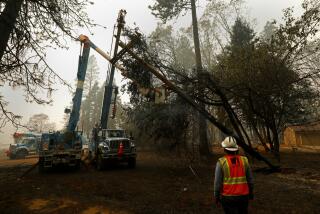PG&E, Newsom and lawmakers had months to plan for a power outage. They didn’t plan enough

The outrage expressed by many mucky-mucks over power blackout hardships reminds me of that classic line from police Capt. Louis Renault in the movie “Casablanca.”
“I’m shocked, shocked to find that gambling is going on in here,” the Claude Rains character exclaims just before the croupier hands him his winnings.
Several utility executives and political leaders seemed shocked, shocked to find that when electricity is shut off, traffic lights go dark and drivers smash their cars. Garage doors won’t open. Food rots in refrigerators. Phones die. Air conditioners don’t cool. Batteries can’t be recharged for power scooters relied on by disabled people. The aged become especially vulnerable.
Also, shock, a company — Pacific Gas & Electric — that for many years has repeatedly proved its incompetence fails miserably to communicate with customers about what to expect.
Gosh, who would have thought?
PG&E execs, the governor, lawmakers and regulators had months to plan for a big power shutdown that everyone knew was coming at some point in an effort to prevent electrical lines from again igniting devastating wildfires.
But they didn’t plan enough. PG&E was trusted and didn’t always keep its word. And when the blackouts became a debacle, our leaders seemed stunned, although some were slow to get there.
As the power outages began, Gov. Gavin Newsom told reporters that the situation was better than the alternative of deadly wildfires. No one would dispute that. But the question was whether deadly wildfires were enough of a present, realistic threat to justify shutting off electricity to 738,000 customers in 35 Northern and Central California counties.
Newsom asserted that “everybody is prepared” for the blackouts and that because of climate change, “this is the new normal.”
In fairness to the governor, his head had been buried in hundreds of legislative bills for several days and he was up against a deadline for acting on them. He also, however, was spending time traveling the state trumpeting housing legislation he had signed.
But by the next day, the blackouts were no longer abstract notions and Newsom was outraged. He changed his tune.
“This can’t be the new normal,” he told reporters at the state’s emergency operations center in Sacramento. “What has occurred in the last 48 hours is unacceptable. We’re seeing a scale and scope of something that no state in the 21st century should experience.”
Yes, you’d think that a big private utility in a state with the world’s fifth-largest economy could deliver electricity when the wind blows 30 mph. And in many darkened places, there was only a 5-mph hint of a slight breeze.
Unlike San Diego Gas & Electric Co. — the role-model utility that politicians and experts point to — PG&E doesn’t have the technical capability to limit its blackouts to small vulnerable areas. It must shut off power for many miles. Its equipment is that outdated.
And so is its customer service. Anxious people were unable to reach the utility on its website or by phone.
I got this email from a friend, Joyce Kiefer, who lives in the heart of Silicon Valley: “One thing that really makes me mad is that PG&E didn’t build an internet system strong enough to withstand all the queries that were bound to come. It doesn’t work and neither do phone calls. PG&E doesn’t take calls.”
Her power was never cut off, but she had heard on TV news that it could be. Like many thousands, she spent an anxious four days huddled with flashlights and candles.
I recently had this pathetic experience with PG&E: The power went off in a Lake Tahoe condo complex where I was staying. I called the utility to find out whether this was a planned outage. The customer service agent needed my address. I didn’t have it. “Can you just tell me whether power is cut off in Kings Beach?” No, he needed my address.
Finally after 10 minutes of fruitless back-and-forth, the PG&E agent said they don’t serve Tahoe. Who does? He rummaged around and produced the name of a company and a phone number. I called.
“This is a resort,” the answerer said. “We’re not in the power business.”
The PG&E guy was clearly untrained.
Another example: During the blackouts, PG&E arranged for a special conference call briefing for legislators. But there was so much static on the line that no one could really hear, one lawmaker told me.
After each PG&E failure — chiefly disastrous wildfires caused by equipment that sets untrimmed vegetation ablaze — utility execs acknowledge they made mistakes and promise to correct them. Then they fail again.
In a harsh letter to PG&E Chief Executive Bill Johnson on Monday, Newsom blamed decades of “prioritizing profit over public safety, mismanagement, inadequate investment in fire safety and fire prevention and neglect of critical infrastructure.”
Give Newsom, former Gov. Jerry Brown and the Legislature credit: Over the last two years, they’ve enacted loads of bills and spent barrels of money aimed at beefing up wildfire fighting and prevention. They’ve also enacted dozens of bills to help utilities — especially PG&E — cope financially with their liabilities to victims. And they’ve stiffened regulations.
Now they and the California Public Utilities Commission need to focus on limiting blackouts and forcing PG&E to treat customers better.
And be skeptical of the utility’s promises. As President Reagan did with the Soviets, “trust but verify.”
More to Read
Start your day right
Sign up for Essential California for news, features and recommendations from the L.A. Times and beyond in your inbox six days a week.
You may occasionally receive promotional content from the Los Angeles Times.







